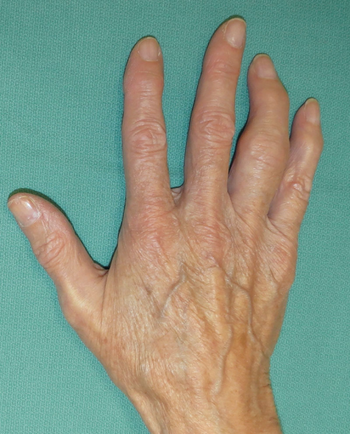Bouchard's nodes
Jump to navigation
Jump to search
| Bouchard's nodes | |
|---|---|
 | |
| Deformity of the right ring proximal interphalangeal joint -Bouchard’s node | |
Bouchard's nodes are hard, bony outgrowths or gelatinous cysts on the proximal interphalangeal joints (the middle joints of fingers or toes). They are seen in osteoarthritis, where they are caused by formation of calcific spurs of the articular (joint) cartilage. Much less commonly, they may be seen in rheumatoid arthritis, where nodes are caused by antibody deposition to the synovium.
Bouchard's nodes are comparable in presentation to Heberden's nodes, which are similar osteoarthritic growths on the distal interphalangeal joints,[1] but are significantly less common.
Bouchard's nodes are named after French pathologist Charles Jacques Bouchard (1837–1915).[2][3]
See also
References
- ↑ Schoen, Delores Christina (2000). Adult Orthopaedic Nursing. Lippincott Williams & Wilkins. p. 60. ISBN 9780781718806. Retrieved 18 January 2018.
Heberden's node.
- ↑ synd/1893 at Who Named It?
- ↑ "Everyday Health: Trusted Medical Information, Expert Health Advice, News, Tools, and Resources". Archived from the original on 2011-07-15. Retrieved 2022-09-10.
External links
| Classification |
|---|